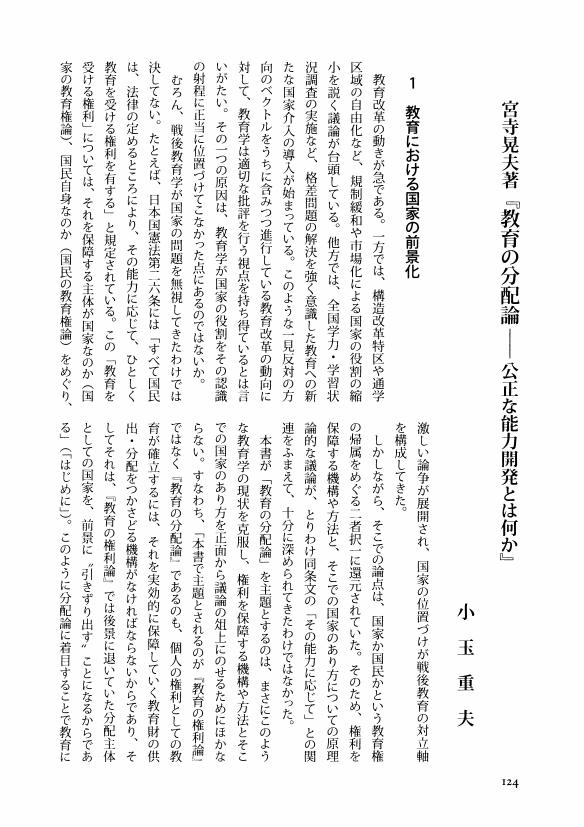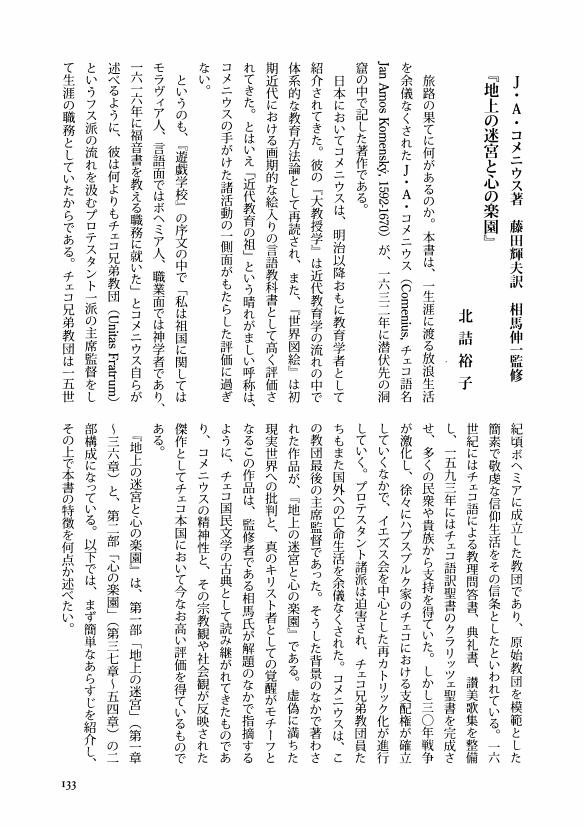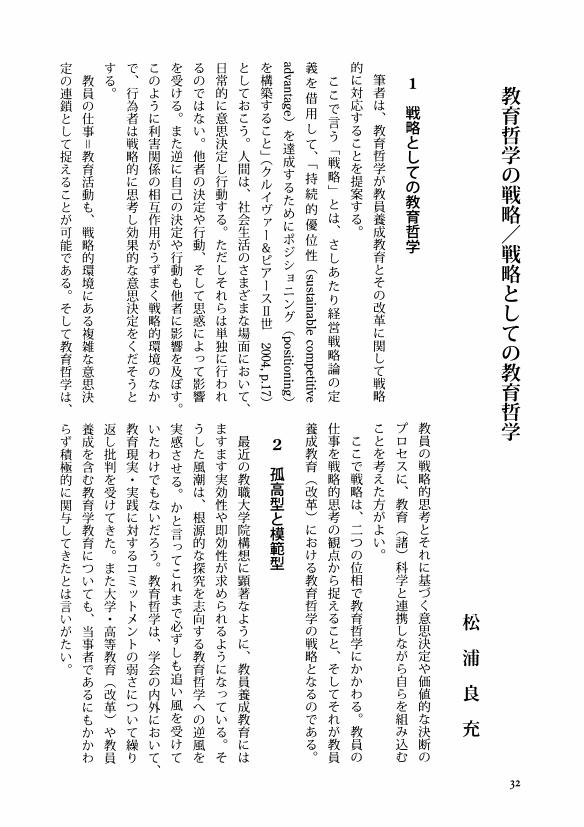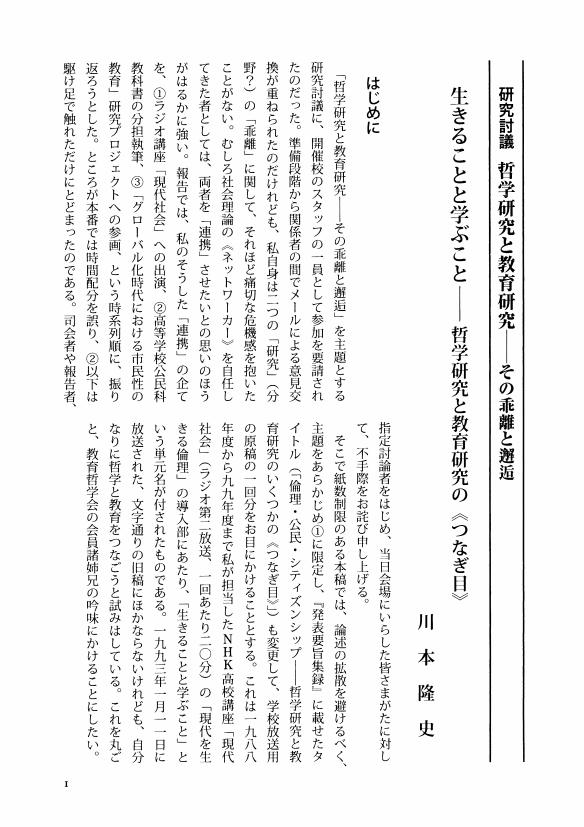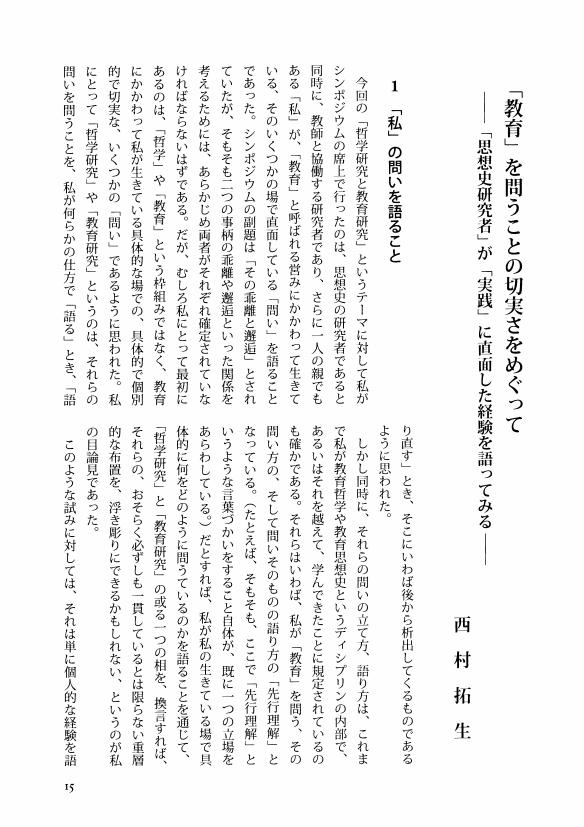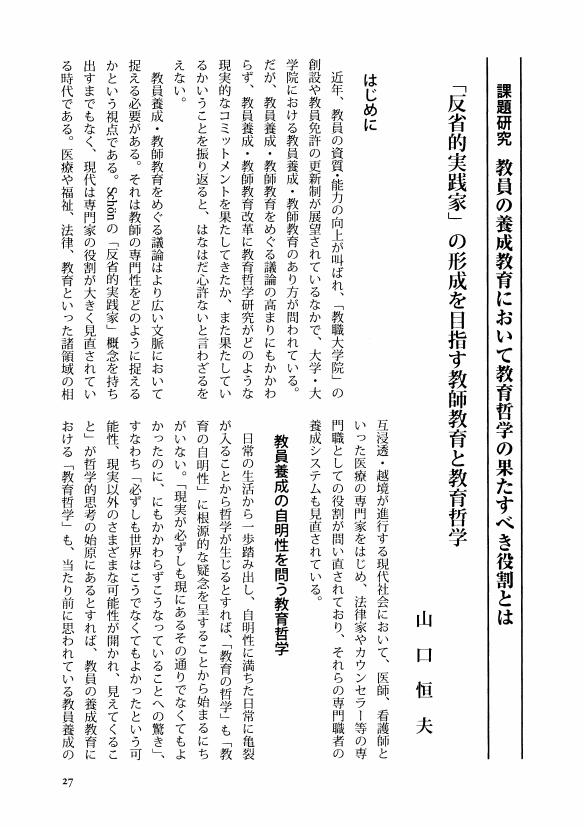1 0 0 0 OA 鈴木晶子著『イマヌエル・カントの葬列-教育的眼差しの彼方へ』
- 著者
- 山名 淳
- 出版者
- 教育哲学会
- 雑誌
- 教育哲学研究 (ISSN:03873153)
- 巻号頁・発行日
- vol.2007, no.96, pp.191-198, 2007-11-10 (Released:2009-09-04)
誰もが-少なくともその名前と哲学史における輝かしい地位については-よく知るイマヌエル・カント。著者である鈴木晶子氏は、近著『イマヌエル・カントの葬列』を、このあまりにも有名な哲学者の、とはいえほとんど語られることのない最期の瞬間を描写することから説き起こしている。ある思想まつこ家の末期から葬儀までの状況描写をもって導入を試みる教育学の書物を、評者は管見にして他に知らない。多くの読者は、まず本書を開いた時点で、このことに意表を突かれ、また衝撃的で謎めいた出だしに惹きつけられるであろう。その一方で、この導入部は、読み返してみると、本書の主調を予示しているという点においては、むしろ必然的でさえあるという印象をも抱かせる。本書は、一九九四年から雑誌『現代思想』において著者が公にしてきた複数の論文を基盤としつつ、それを死生の観点から編み直したものである。この死生をめぐる著者の関心が、すでに本書の入り口辺りで漂っている。死生という観点からの編み直しが、教育学研究としての著者の大きな賭けであるように思われるのだが、その点については後述する。本書は、第I部「カントを失う」 (第一、二、三章) 、第11部「教育の世紀」 (第四、五章) 、第III部「喪の技法」 (第六、七、八章) の三部で構成されており、さらに、第II部と第III部の間に「間奏曲」として「発達の行方」という論考が収められている。本書の樹幹をなしているのは、「カントが呈示した問題系が教育的思考様式や教育学という学問形式にどのように受け継がれ、あるいは忘却されたか」 (「はじめに」vii頁) という問いである。すべては、直接的または間接的に、カントをめぐる問題とかかわっている。とはいえ、本書は多層的に読み込むことができるようにできており、とりあげられている主題や話題は多岐にわたる。本書の構成にしたがって各章の内容を順番に一通りなぞることによって本書を見渡すことは、評者には到底できそうもない。ここでは、著者による上述の問いにしたがって、とはいえ評者の関心にもとづきつつ、まず<カントの継承>という視点から、最も重要であると思われるいくつかの章の概要を示してみたい。その後、<カントの継承>についての論述に折り重ねられている<カントの忘却>についての論述がどのようなものであるかを確認し、最後に、そのようなカント問題との格闘の末に浮上する死生の教育思想に注目して、本書の核心部分を読み直してみようと思う。
1 0 0 0 OA 吉田敦彦著『ブーバー対話論とホリスティック教育-他者・呼びかけ・応答』
- 著者
- 菱刈 晃夫
- 出版者
- 教育哲学会
- 雑誌
- 教育哲学研究 (ISSN:03873153)
- 巻号頁・発行日
- vol.2007, no.96, pp.199-206, 2007-11-10 (Released:2010-05-07)
本書は、京都大学博士 (教育学) 学位論文に、若干の補筆訂正をして出版されたものである。学位申請に当たっては、著者による先行図書『ホリスティック教育論』 (日本評論社) が参考論文として付されたとある。タイトルの通り、本書の主眼は、まずブーバー対話論の解明にある。が、それとホリスティツク教育が、どうかかわるのか。他者、呼びかけ、応答とは、何か。学位に相当する知見として、ブーバー研究上の貢献として、何があるのか。この点について、著者自身、こう述べている。「ブーバーの人間学や教育論に関する優れた先行研究が多々あるなかで、本書のもつブーバー研究上の貢献があるとすれば (中略) 、現代のホリスティック教育からのアクチユアルな問いかけによって、全体主義や神秘主義に対する彼の対話論の『他者性』や『応答性』のもつ意義を際立たせ、またその視角から彼の対話論の人間形成論としての特質を捉える点にある」 (十一-十二頁) 。あるいは、こうも記されている。「すぐれた先行研究のあるブーバー教育思想研究に対して、本書の研究が貢献しうるとすれば、 (中略) ブーバー対話論の人間形成論としての解読を『全体性』を鍵概念として試みた点にある。いま一度その読解の観点について言えば、本研究は、『人間形成』の主体たる〈世界〉と、自らも形成される客体でありながら『教育』の主体たらんとする『教育者』との間の、その対話的連関を、〈世界〉との間の垂直方向 (聖性) および他者との問の水平方向 (全体性) を交えた『対話』理解を通して、解明したものである」 (二五七頁) 。要するに、ブーバー対話論をホリスティック教育の観点から解読したのが、本書である。すると、ブーバー村話論においては、「他者性」と「応答性」が、聖性と全体性のなかの重要なファクターとして浮き上がってくるという。聖性も全体性も、一歩でも道を踏み誤ると、一方は心理主義や神秘主義、また他方は全体主義や同一化へと急速に傾斜しかけない危険性を常に抱えている、そこでは、「狭き尾根道」を注意深くたどる必要がある。読者は、著者とともに、この「狭き尾根道」をまさに対話しながら、たどることになる。果たして、踏み外すことなく、うまくたどることができるであろうか、できたであろうか。対話になった、であろうか。再度確認しておこう。本書は、「M・ブーバー (MartinBUber1878-1965) の『応答的対話』に関するテキストを、物語論や他者論のインパクトを経た現代思想の地平において、ホリスティック教育が探求する『全体性』と『聖なるもの』に関わる課題意識にしたがって読み解き、その人間形成論的な含意を解き明かすものである」 (四頁) 。構成は次の通りである。二部からなっている。
1 0 0 0 OA 分有の思考へ ブーバーの神秘主義的言語を対話哲学へ折り返す試み
- 著者
- 小野 文生
- 出版者
- 教育哲学会
- 雑誌
- 教育哲学研究 (ISSN:03873153)
- 巻号頁・発行日
- vol.2007, no.96, pp.42-62, 2007-11-10 (Released:2010-05-07)
- 参考文献数
- 72
Martin Bubers Denken wird immer wieder so verstanden, dass er seine frühere mystische Neigung, sogenannt 'Erlebnis'-Mystik', überwunden und dadurch zum dialogischen Denken entwickelt hat : 'Von der Mystik zum Dialog'. Diese Auffassung kann zwar noch wichtig und bedeutend bleiben, es müsste aber zugleich wertvoll und notwendig sein, wirkliche Bedeutungen solcher Überwindung und Entwickelung nachzuprüfen, ohne seinen Gedanken einfach zu schematisieren, sondern um aller Moglichkeiten seines dialogischen Denkens willen.In diesem Aufsatz wird es versucht, seinen mystischen Gedanken tiefer und ausführlicher zu erforschen, fokussiert auf die Sprache in der Mystik, vor allem die besondere Bedeutung 'des Unsagbaren' urn die Jahrhundertwende im deutschsprachigen Raum.Zweitens wird die skeptische Sprachkritik und Mystik von Fr. Mauthner und G. Landauer erforscht und dabei werden ihre Zusammenhänge mit Bubers Problematik, d.h. der Universalienstreit und Individuationsproblem deutlich gemacht. Diesbezüglich wird Bubers Dissertation 'Zur Geschichte des Individuationsproblems' untersucht, deren Bedeutsamkeit in der Tat kaum genug beachtet wird.Aus diesen Untersuchung werden die erste Sätze von 'Ich und Du', dessen Kerngedanke darin symbolisiert wird, aus der mystischen Perspektive wieder interpretiert und neu bewertet : Z. B. die verschiedene Bedeutungen von 'zwiefältig/ Zwiefalt'. Dieser Buber'sche Begriff, m. E. enthält den mittelalterlich-mystischen Sinn wie partitipatio, complicatio, Entfaltung, Umfassung u.s.w.Dass Bubers Denken des Partizipierens durch die Zwiefalt, nämlich Fältigkeit, von Potenzieren-Verwirklichung oder Transzendenz-Immanenz konstruiert wird, fließt folglich in die Form der Ankunft des Rufs in seinem dialogischen Prinzip wie wesentliches Paradoxa von Du-Es-Zwiefältigkeit ein, und wir müssen für diese inhaltvolle Bedeutsamkeit mehr Aufmerksamkeit zeigen.
1 0 0 0 OA 啓蒙主義者カンペの言語論におけるロマン主義的変容 モーリッツとの比較を手がかりに
- 著者
- 山内 規嗣
- 出版者
- 教育哲学会
- 雑誌
- 教育哲学研究 (ISSN:03873153)
- 巻号頁・発行日
- vol.2007, no.96, pp.63-79, 2007-11-10 (Released:2010-01-22)
- 参考文献数
- 56
Purpose of this paper is to reexamine the positioning of the educational thought of Joachim Heinrich Campe which is a representative model of the educational thought in the Enlightenment, in comparison to the theory of Karl Philipp Moritz. Moritz as an early Romanticist tried in his language theory to establish a methodology for creating the universal language through self-analysis and on the basis of his own experiential psychology. Campe showed a necessity for stipulating concepts and an expectation for the public in his criticism of Moritz based upon Enlightenment psychology. This led him to the reconstruction of language through dictionary compilation in the occasion of the French Revolution. In that process Campe constructed a place for the Enlightenment theory of language, by describing the criticism of Moritz. Ironically, however, this turned out to give the latent character of Romanticism to the dictionary. On the basis of this transfiguration, various interpretations of the Campe's language theory were united in one dynamic image. Furthermore, a link between the Enlightment and Romanticism was established through the transfiguration of Campe's theory of language.
1 0 0 0 OA 実践者が記録を書くことの意味 武田常夫の記録に基づく現象学的考察
- 著者
- 田端 健人
- 出版者
- 教育哲学会
- 雑誌
- 教育哲学研究 (ISSN:03873153)
- 巻号頁・発行日
- vol.2007, no.96, pp.97-114, 2007-11-10 (Released:2009-09-04)
- 参考文献数
- 23
Es ist eine historische Tatsache, daß viele japanische Lehrer ihr eigenes Schuldasein literarisch dokumentiert haben. Die Bedeutung und Wirkung dieses Dokumentierens, durch das als solches er sich entwickeln konne, waren bishernur empirisch bekannt. In diesem Aufsatz soll also dieses Verhalten anhand derSicht von W. Dilthey und M. Heidegger klar gemacht werden. Urn diese Aufgabekonkret zu erfüllen, nehmen wir als Beispiel das Dokument Tsuneo Takedas, der ein Grundschullehrer war.Takeda hat seine eigene Erfahrung der Entfaltung als Lehrer beschrieben, dieer mit Hilfe des Dokumentierens gemacht hat. Urn die Erfahrung zu beschreiben, benutzt er den Begriff “Gestaltung” der Erlebnisse durch literalischen Ausdruck.Gerade im Prozess des Ausdrückens eines praktischen Erlebnisses, der die willkürliche subjektive Darstellung überwindet, ereignet sich diese Gestaltung. Im 1. und 2. Abschnitt wird dieser Prozess nach Dilthey erortet, und ausgelegt, so daß die Erinnerungen, in denen die praktischen Ereignisse aufgefaßt werden, zu “Erlebnissen fortgezogen” werden, welche im Verlauf des Lebens strukturellmit solchen Momenten verbunden waren. Der Erlebnisausdruck bei solchenErinnerungen allein kann den seelischen Zusammenhang aus den Tiefen heben, diedurch Introspektion und Beobachtung nicht erhellt werden.Takedas Erfahrung der Dokumentierung hat eine dunkle Stelle, die anhandDiltheys nicht mehr ans Licht gezogen wird. Außerdem muß man sich auf dieStimmung des Lehrers konzentrieren, an die Dilthey nicht genug gedacht hat, umden Lebenszusammenhang des Lehrers zu erkennen. Dafür soll Heidegger unseinen Anhalt gewähren.Im 3. Abschnitt wird zuerst anhand von Heidegger geklärt, daß dieGrundstimmung den Zustand vor und über allem Erkennen und Willen eroffnet, in dem wir jeweils zu den Dingen, zu uns selbst und zu den Menschen urn unsstehen. Danach wird erbrtert, daß die Freude d.h. das Aufgeräumte, das Takedain seiner Tätigkeit angestrebt und in seinem Dokument beschrieben hat, diejenigeGrundstimmung ist, die allein den Kindern den ihnen gernäßen Ort einzuräumenvermag, und in der die “Natur” der Kinder heil bewahrt ist. Anschließend wirdgezeigt, daß der Lehrer seine Praxis dokumentiert, urn dasjenige Aufgeräumtezu finden, worin er mit Kindern zu wohnen und die Natur der Kinder im Wort zu behüten bedacht ist.
1 0 0 0 OA 言語の呪縛と解放 ウィトゲンシュタインの哲学教育
- 著者
- 丸山 恭司
- 出版者
- 教育哲学会
- 雑誌
- 教育哲学研究 (ISSN:03873153)
- 巻号頁・発行日
- vol.2007, no.96, pp.115-131, 2007-11-10 (Released:2010-01-22)
- 参考文献数
- 17
It is said that Ludwig Wittgenstein is one of the most important linguistic philosophers in the twentieth century. Indeed, his contribution to the “Linguistic Turn” is prominent. His interest, however, is not in language itself but in the emancipation of his students and readers from pictures that have held them captive. The purpose of this paper is to understand the point of Wittgenstein's philosophy by considering how he frees them in teaching philosophy.The paper firstly argues that Wittgenstein's philosophy is likely to be misunder-stood even by major Wittgensteinian scholars, and that his philosophy should be characterized as edifying philosophy, one that Richard Rorty distinguishes from systematic philosophy.The paper then discusses the purpose of Wittgenstein's philosophy and his philosophical methods. While he held a consistent concept of philosophy from the early to the later periods, he changed his view on philosophical methods. The paper finds a connection between two periods by elaborating on the “elucidating” function of his philosophy, and his idea of an “overview” as a philosophical technique. It shows that Wittgenstein's philosophy is motivated by his pedagogical concerns about the emancipation of his students and readers from their conceptual captivity that causes philosophical confusions.Finally this paper examines closely Wittgenstein's practice of teaching philosophy. It reconstructs his teaching in his class by using his students' memoirs, and analyses his Philosophical Investigations in terms of the idea of teaching as a philosophical technique of emancipation. His teaching in the classroom and his writings have some common features such as a dialogical style, presenting imaginary examples one after another, and encouraging students or readers to think by themselves. It is concluded that readers of Wittgenstein are expected to see beyond his teaching by learning from him how to emancipate themselves.
1 0 0 0 OA 宮寺晃夫著『教育の分配論-公正な能力開発とは何か』
- 著者
- 小玉 重夫
- 出版者
- 教育哲学会
- 雑誌
- 教育哲学研究 (ISSN:03873153)
- 巻号頁・発行日
- vol.2007, no.95, pp.124-129, 2007-05-10 (Released:2009-09-04)
1 0 0 0 OA J・A・コメニウス著 藤田輝夫訳 相馬伸一監修『地上の迷宮と心の楽園』
- 著者
- 北詰 裕子
- 出版者
- 教育哲学会
- 雑誌
- 教育哲学研究 (ISSN:03873153)
- 巻号頁・発行日
- vol.2007, no.95, pp.133-135, 2007-05-10 (Released:2009-09-04)
1 0 0 0 OA 教育哲学は教職の自律を可能にするか 進歩主義の教師教育論からの示唆
- 著者
- 宮本 健市郎
- 出版者
- 教育哲学会
- 雑誌
- 教育哲学研究 (ISSN:03873153)
- 巻号頁・発行日
- vol.2007, no.95, pp.38-43, 2007-05-10 (Released:2009-09-04)
- 参考文献数
- 8
現代の日本において教育哲学が果たすべき役割を考えると、まず、教師が教育目的に関する議論ができる状況を作り出すことが必要である。あらゆる教育実践には、名目上にすぎないものであっても、かならず教育目的が存在している。だが多くの場合、教師はそれを自覚しないか、自覚できない状況に陥っている。この無自覚の教育実践を自覚化し、批判することが、教育哲学の役割である。だが、理念派のように、教育目的の自覚・批判を教師の教養に委ねるならば、教育哲学の課題は、結局は教師の人格の問題に帰着する。教育の目的についての考察が必要であることを強調すればするほど、理念派の立てた教育目的が、ひとりひとりの教師の教育実践から乖離していく。このときに必要なのは、教室での自分自身の教育実践から出発する現場派の教育哲学である。それは大学院の研究者によって与えられるものではなくて、教師が自分自身の教育実践のなかでつくりあげるものである。
1 0 0 0 OA 課題研究に関する総括的報告
- 著者
- 森川 直 渡邉 満
- 出版者
- 教育哲学会
- 雑誌
- 教育哲学研究 (ISSN:03873153)
- 巻号頁・発行日
- vol.2007, no.95, pp.44-50, 2007-05-10 (Released:2009-09-04)
1 0 0 0 OA J・S・ミルにおける功利主義と教育思想の関係
- 著者
- 高宮 正貴
- 出版者
- 教育哲学会
- 雑誌
- 教育哲学研究 (ISSN:03873153)
- 巻号頁・発行日
- vol.2007, no.95, pp.51-70, 2007-05-10 (Released:2010-05-07)
- 参考文献数
- 19
The purpose of this paper is to clarify the relationship between J. S. Mill's utilitarianism and his educational thought. For Mill, utilitarianism must ground educational thought so long as it shows the purpose of human life.The following points will be discussed in this paper.1. The feature of Mill's utilitarianism is to introduce not only the first principle, “the Greatest happiness principle, ” but also “secondary principles” such as liberty and virtue. Each “secondary principle” has its own priority unless it conflicts with each other. Education and instruction are regarded as “secondary principles” as they enable people to learn the tendencies of actions. Education restricts the application of “the principle of liberty, ” which is one of the “secondary principles.” “The principle of liberty” affirms the liberty of “self-regarding” action, but nonage and children, who cannot act rationally, are not qualified to be endowed with this liberty.2. According to Mill, utilitarianism requires moral education for its realization and justification. This moral education must be conducted by developing one's own individuality. The purpose of this moral education can be accomplished not only by providing systematic education, but also by using the forces of social institutions, public opinions, and religion.
1 0 0 0 OA 「終焉の自覚」から人間が誕生したとすれば……
- 著者
- 土戸 敏彦
- 出版者
- 教育哲学会
- 雑誌
- 教育哲学研究 (ISSN:03873153)
- 巻号頁・発行日
- vol.2007, no.95, pp.89-100, 2007-05-10 (Released:2009-09-04)
日々、茶飯事にかまけていると、見えるもの、考えることのほとんどはその茶飯事のみ、ということになりがちである。とりわけ昨今の職場環境や世の動きの尋常ならざる気忙しさは、ものごとの深奥に分け入ることを許そうとしない。だが、時として日常のなかに漂うささやかな浮遊空間に身を委ねてみると、得体の知れない疑問が浮上してくることもある。たとえば創世期、生命体は自身から分身を生み出していたし、現在でもそのような生命体が存在する。しかるに、どういうわけで雌(女)と雄(男)の二種があるのか。あるいはまた、食し飲することは、生命体にとって仲間とともに楽しみつつ公然と行なわれる活動であろう。それなのにわが人間にあっては、同じ生きる際の重要な活動である生殖については口にすることさえはばかられるのは、どうしてなのか。等々。ひとによって「教育」という問題に対する向き合い方はそれぞれさまざまであろう。私の場合、いろいろ彷復ったあげく最後には、人間を含めた生命にまつわる疑問に行き着いてしまう。
1 0 0 0 OA 教育哲学を考える
- 著者
- 桜井 佳樹
- 出版者
- 教育哲学会
- 雑誌
- 教育哲学研究 (ISSN:03873153)
- 巻号頁・発行日
- vol.2007, no.95, pp.101-102, 2007-05-10 (Released:2009-09-04)
教育哲学とは何か。この問いを他者から問われることもあれば、自ら問うこともある。教育にまつわる様々な問題を哲学的に考察することである、と一応答えたとしても、おそらく答えたことにはならないだろう。国とは何か。国を愛することとは何か。心とは何か。/大学とは何か。学校とは何か。/教師とは何か。教員養成とは何か。/教養とは何か。人間形成とは何か。/子どもとは何か。大人とは何か。/そして、教育とは何か。……これら一群の問いにすぐに答えを用意している者はどれだけいるだろうか。教育哲学は体系化された知の体系ではなく、これらの問いの探究や解の吟味の中にある。というのも一つの解では包括し得ない別解の存在を隠蔽してしまうからだ。教育哲学はこれらの問いの答えを創造すると同時にそれを即座に破棄し、再度作り直すというダイナミズムのなかにある。それが真剣な問いである場合もあれば、その行為自体と戯れる場合もある。
1 0 0 0 OA 一九二〇年代の子どもをめぐるまなざし 「内なる子ども」
- 著者
- 寺岡 聖豪
- 出版者
- 教育哲学会
- 雑誌
- 教育哲学研究 (ISSN:03873153)
- 巻号頁・発行日
- vol.2007, no.95, pp.103-107, 2007-05-10 (Released:2010-01-22)
教育哲学会第四九回大会 (東京大学教育学部) において、寺岡聖豪 (福岡教育大学) 、木内陽一 (鳴門教育大学) 、岡谷英明 (高知大学) の三名は「一九二〇年代の子どもをめぐるまなざし-「内なる子ども」-」というテーマで、ラウンド・テーブルを開催した。会場には約二〇名の方々が集まり、活発な議論が展開された。以下は提案者三名の報告と参加者の感想をもとにまとめたものである。それぞれの項目は担当者が執筆しているが、最終的な文責は企画者 (寺岡) が負う。
1 0 0 0 OA 教育哲学の戦略/戦略としての教育哲学
- 著者
- 松浦 良充
- 出版者
- 教育哲学会
- 雑誌
- 教育哲学研究 (ISSN:03873153)
- 巻号頁・発行日
- vol.2007, no.95, pp.32-37, 2007-05-10 (Released:2009-09-04)
- 参考文献数
- 5
1 0 0 0 OA 生きることと学ぶこと-哲学研究と教育研究の《つなぎ目》
- 著者
- 川本 隆史
- 出版者
- 教育哲学会
- 雑誌
- 教育哲学研究 (ISSN:03873153)
- 巻号頁・発行日
- vol.2007, no.95, pp.1-7, 2007-05-10 (Released:2009-09-04)
1 0 0 0 OA 乖離の系譜学
- 著者
- 加藤 守通
- 出版者
- 教育哲学会
- 雑誌
- 教育哲学研究 (ISSN:03873153)
- 巻号頁・発行日
- vol.2007, no.95, pp.8-14, 2007-05-10 (Released:2009-09-04)
- 参考文献数
- 9
- 著者
- 西村 拓生
- 出版者
- 教育哲学会
- 雑誌
- 教育哲学研究 (ISSN:03873153)
- 巻号頁・発行日
- vol.2007, no.95, pp.15-21, 2007-05-10 (Released:2009-09-04)
- 参考文献数
- 4
1 0 0 0 OA 研究討議に関する総括的報告
- 著者
- 齋藤 直子 西平 直
- 出版者
- 教育哲学会
- 雑誌
- 教育哲学研究 (ISSN:03873153)
- 巻号頁・発行日
- vol.2007, no.95, pp.22-26, 2007-05-10 (Released:2009-09-04)
1 0 0 0 OA 「反省的実践家」の形成を目指す教師教育と教育哲学
- 著者
- 山口 恒夫
- 出版者
- 教育哲学会
- 雑誌
- 教育哲学研究 (ISSN:03873153)
- 巻号頁・発行日
- vol.2007, no.95, pp.27-31, 2007-05-10 (Released:2009-09-04)
- 参考文献数
- 3
